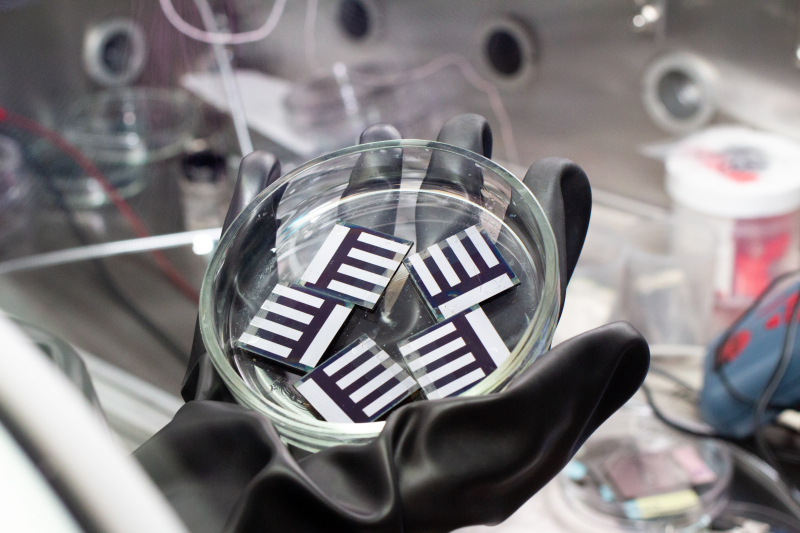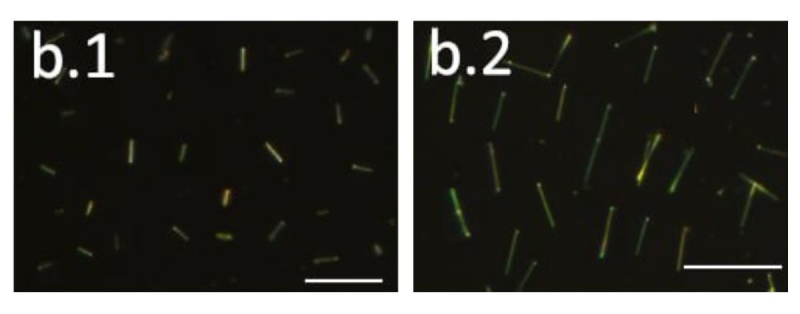Scientists at ITMO University and their colleagues from the St. Petersburg Academic University and University of Tor Vergata (Italy) have developed high-performance perovskite solar cells. The improvement is thanks to the use of semiconductors based on wire-like nanocrystals. The technology is said to offer up new prospects for the production of next-gen solar power stations and optical devices. The results of the study were published in ACS Applied Energy Materials.

Solar cell samples. Photo by Ekaterina Shevyreva / ITMO.NEWS
Perovskite, not silicon
Today, solar cells are most often made with the use of silicon – approximately 95% of today’s solar photovoltaics market is taken up by such devices. And even though their energy conversion efficiency has grown by 16-20% (or even 24-26% in lab conditions) in the past 10-15 years, it’s still not quite so high. In fact, the theoretical maximum performance threshold for silicon single-crystal cells is considered to be around 29.4%.
There are other drawbacks, too. To absorb enough light, silicon solar cells must be sufficiently thick – which makes them ill-suited for use in flexible solar cells.
That’s why scientists are looking into other materials as possible bases for solar cells – and one such option is perovskites. These are light, thin, and cheap semiconductors that can easily be scaled up and used to develop thin solar cells of various shapes. Theoretically, perovskites can be used to create light, portable energy sources for anything from phones and earbuds to entire smart homes.
Still, perovskites, like all other semiconductors, have their limitations: for one, they can only absorb a specific range of the light spectrum. What this means in practice is that perovskite-based solar cells will absorb a limited part of the spectrum and, therefore, produce less energy than provided by the source. A possible solution to the problem lies with multi-stage solar cells – or, put more simply, cells consisting of several semiconductor materials (like perovskite and A3B5 semiconductors), each focused on absorbing a specific part of the solar spectrum.

A3B5 semiconductor samples on an electron transport layer before being covered with perovskite. Image courtesy of the research team
The solution
A team of researchers from ITMO University, the St. Petersburg Academic University and University of Tor Vergata (Italy) conducted several experiments with samples of A3B5 semiconductors. This new and promising class of semiconductors, which is composed of wire-like nanocrystals, was incorporated into perovskite solar cells for the first time.
Their electrophysical properties, such as capacity for light absorption, low optical losses, thermal conductivity, and heat transfer capabilities are optimal compared to other conductors. Notably, lab prototypes of solar cells that incorporate several photoactive semiconductors are capable of absorbing most of the visible spectrum and converting it to electricity with 40% efficiency, which is considered a great success.
Thanks to the incorporation of A3B5 semiconductors into perovskite solar cells, the researchers managed to improve the efficiency of light-to-energy conversion from 17% to 18.8%.

Samples of A3B5 semiconductors: 1) grown on a silicon substrate; 2) positioned on top of a perovskite device. Image courtesy of the research team
The course of the study
The researchers first selected a variation of A3B5 semiconductors with the required physical properties. They chose gallium phosphide (GaP), as it can be used to create nanomaterials that have low optical losses, optimal electrophysical properties, and excellent light localization, making them especially well-suited for the production of modern optoelectronic devices.
Wire-like gallium phosphide nanocrystals were then incorporated into perovskite solar cells. The combination of two semiconductors (perovskite and A3B5) creates a solar cell that is capable of producing more energy. This effect is caused by the optimization of charge extraction: the electric charge that is generated by the light is transferred via the incorporated nanocrystals with greater efficiency.
“This is our first attempt at combining different types of semiconductors: we plotted energy-level diagrams for various semiconductor-based devices and then determined the optimal composition of wire-like nanocrystals for charge transfer in perovskite solar cells. We also created a prototype of a gallium phosphide solar cell that proved to be 1.8% more efficient than its counterparts. In the future, this study will serve as a foundation for the engineering of new solar cells comprising multiple photovoltaic layers of A3B5 compounds and perovskites,” said Aleksandra Furasova, a junior research associate at the Faculty of Physics.

Aleksandra Furasova. Credit: Dmitry Grigoryev / ITMO.NEWS
Future prospects
The results of the study can be used to make various types of thin-film solar cells with different compositions of active materials, as well as in other optoelectronic devices. For example, they might come in handy when designing solar cells to power light autonomous devices or space satellites – in the case of the latter, their weight is directly related to how much fuel is required to launch them into orbit. Another possible use for these cells is as a wireless energy source for Internet of Things networks.
In the future, scientists plan to create A3B5-based solar cells with various other nanostructures.
Reference: Aleksandra Furasova, Maria Baeva, Alexey M. Mozharov, Pavel Tonkaev, Sergey Raudik, Vladimir Neplokh, Vladimir V. Fedorov, Francesco Di Giacomo, Ivan S. Mukhin, Sergey V. Makarov, Aldo Di Carlo (ACS Applied Energy materials, 2023)
Elizaveta Kokorina
Journalist
Vadim Galimov
Translator
Mikhail Evdokimov
Translator
